Occupational environment monitoring of a children’s toy manufacturing factory
99,000 ₫
Note: The above price is calculated for one sample, and the price may fluctuate depending on the area of the environment to be monitored and market movements. For more accurate pricing support, please refer to the price list or contact our consulting staff directly.
Monitoring the environment of a children’s toy manufacturing factory is a session of collecting, analyzing, and evaluating factors at the workplace that may harm workers health.
Table of Contents
Toggle1. Overview of the Children’s Toy Manufacturing Factory
a. What is a children’s toy manufacturing factory?
Factory producing children’s toys is a production facility aimed at manufacturing toys for children. These toys can be made from various materials such as plastic, wood, fabric, rubber, metal, and other composite materials. The toys may include models, bicycles, dolls, toy guns, educational products, and many other types of products.

b. Production stages in the children’s toy manufacturing factory
The production stages in a children’s toy manufacturing factory typically include:
- Product design: This is the first stage in toy production, where manufacturers generate ideas and designs for the products. These ideas are determined by factors such as the age of the children, product characteristics, and children’s developmental skills.
- Mold making: After completing the design, manufacturers create a mold. This mold is used to produce replicas of the product.
- Material preparation: The materials used to manufacture children’s toys depend on the type of product. Common materials include plastic, wood, metal, fabric, and fibers.
- Production: The production process varies depending on the product type, but it typically includes cutting, welding, assembling, coloring, shaping, and printing.
- Quality control: Before the products are released to the market, they are quality-checked to ensure safety and durability.
- Packing and delivery: Once checked and packaged, the products are sent to stores or distributors to reach the end customers.

c. Machinery used in the children’s toy manufacturing factory
Various machinery is used in a children’s toy factory to perform different production stages. Common machines include:
- Plastic molding machines: Used to shape plastic into diverse forms to create toy parts.
- Cutting and stamping machines: Used to cut and stamp small toy parts, such as wings, legs, arms, heads, etc.
- Printing machines: Used to print on toy surfaces, including images, letters, numbers, and other features.
- Sanding machines: Used to sand toy surfaces to achieve the required smoothness and gloss.
- Packing machines: Used to package finished products into boxes or packaging for sale.
Additionally, the toy manufacturing factory may use other machines such as spray painting machines, laser engraving machines, balancing machines, testing machines, etc., depending on production scale and product complexity.

d. Occupational diseases for workers in children’s toy factories
Workers in children’s toy manufacturing factories may be exposed to many harmful substances and hazardous factors that can cause occupational diseases. Some common occupational diseases in the toy manufacturing sector include:
- Pneumonia: Due to exposure to dust and fumes from materials such as fiberglass, plastic powder, wood powder, paints, and adhesives.
- Headaches and fatigue: Caused by exposure to chemicals such as formaldehyde, benzene, toluene.
- Skin allergies: Due to contact with chemicals and fiberglass.
- Eye diseases: From exposure to bright light, dust, and other agents.
- Tinnitus: Due to exposure to loud noise from production machinery.
- Hand injuries: From working with tools, machinery, and heavy materials.
- Spine and wrist disorders: Due to prolonged standing or sitting.
- Joint diseases: From repetitive work.
- Respiratory diseases: Due to dust and smoke from production materials.
- Digestive system disorders: From contact with chemicals and fertilizers during production.
To ensure worker safety, protective measures such as wearing masks, personal protective equipment, minimizing exposure to hazardous substances, controlling air pollution, and maintaining hygiene are necessary.

e. Popular types of children’s toys on the market
There are many popular types of children’s toys on the market, including:
- Bicycles, strollers, toy cars
- Dolls, stuffed animals
- Puzzles and construction toys
- Educational and intellectual toys
- Remote-controlled toys, airplanes, helicopters, robots
- Musical toys, pianos, guitars, drums
- Model toys, cars, trains, trucks, airplanes, ships
- Sports toys, football, basketball, volleyball, badminton
- Outdoor toys, playground equipment, swings, slides, climbing frames
- Imaginative play toys, role-playing, dancing, singing
These toys must be produced and quality-checked to ensure they are safe for children.

2. Overview of Occupational Environment Monitoring Services
a. What is occupational environment monitoring in a children’s toy factory?
Occupational environment monitoring (or occupational environment assessment) in a children’s toy factory is the activity of collecting, evaluating, and analyzing measurement indicators of workplace environmental factors in the toy manufacturing factory. The aim is to implement timely measures to minimize environmental hazards affecting workers’ health and prevent occupational diseases. Occupational environment monitoring is mandatory for children’s toy factories.
Occupational environment monitoring plays a vital role in caring for, protecting, and enhancing worker health because workers are the main resource and directly generate profits for businesses. Workers regularly exposed to risks or occupational hazards exceeding permissible limits may suffer health consequences and occupational diseases.
REGISTER FOR OCCUPATIONAL ENVIRONMENT MONITORING SERVICE
b. Nam Viet’s occupational environment monitoring program
Nam Viet’s occupational environment monitoring program is developed by monitoring engineers specializing in occupational safety and environmental protection. With the goal of ensuring worker health and safety, the program uses modern measurement methods to monitor air, water, and microclimate, physical, and dust factors in the workplace. This program is crucial for ensuring a safe working environment and protecting workers’ health.
Additionally, Nam Viet’s program plays an important role in researching and developing solutions to improve workplace environmental quality. With the dedication and professionalism of the monitoring experts, Nam Viet’s exclusive monitoring program is becoming a breakthrough in occupational safety and environmental management in Vietnam.

c. Standardization in workplace measurement procedures
Standardization in Nam Viet’s occupational environment measurement procedures is critical for ensuring the quality of measurement results. To ensure accuracy and reliability, the program follows recognized standards and standardized procedures issued by the Ho Chi Minh City Department of Health. This ensures that collected data can be used reliably in assessing the workplace environment and making decisions to improve it for worker health protection.
These standardized procedures also ensure that measurements are conducted by highly qualified monitoring specialists with many years of experience, allowing managers and experts to trust the results from An Toan Nam Viet and make accurate, valuable decisions to protect worker health and the environment.
By applying standardized workplace measurement procedures, Nam Viet demonstrates its commitment to ensuring a safe working environment and protecting worker health, while also contributing to the development and improvement of occupational safety and environmental management in Vietnam.
d. Reporting results of occupational environment monitoring in a children’s toy factory
Monitoring results are prepared according to Form No. 04, Appendix III issued with Decree 44/2016/ND-CP and is prepared in two copies: one sent to the enterprise that signed the monitoring contract, and one retained by the monitoring organization.
The retention period for occupational environment monitoring results is indefinite according to legal regulations.

e. Frequency of occupational environment monitoring according to law
According to Clause 2, Article 18 of the Law on Occupational Safety and Health 84/2015/QH13, employers must organize occupational environment monitoring to assess harmful factors at least once a year.
f. Deadline for submitting occupational environment monitoring results
The submission deadline is before December 31 each year. Enterprises at production facilities are required to submit the occupational environment monitoring results to the local Department of Health where the enterprise’s head office is located and where the workers are employed.
When there are changes in technology processes, production processes, or during renovation/upgrading of workplaces that may create new harmful factors to workers’ health, enterprises must update occupational hygiene records concerning harmful factors to be monitored.
g. Regulations on penalties for violations of occupational environment monitoring by employers
According to Article 27 of Decree No. 12/2022/ND-CP dated January 17, 2022, on administrative penalties in labor, social insurance, and Vietnamese workers working abroad under contracts:
- Clause 2: A fine of 2,000,000 – 5,000,000 VND for employers who do not publicly disclose monitoring results to workers at the monitoring site and at places where hazardous factors are assessed and managed immediately after obtaining occupational environment monitoring results and hazardous factor assessment results.
- Clause 3: A fine of 20,000,000 – 40,000,000 VND for employers who fail to conduct occupational environment monitoring to control health hazards according to the law.
- Clause 4: A fine of 40,000,000 – 60,000,000 VND for employers who collude with monitoring organizations to commit fraud in occupational environment monitoring activities but not to the level of criminal liability.
3. Harmful Environmental Factors for Workers in Children’s Toy Manufacturing Factories
Harmful environmental factors for workers in children’s toy manufacturing factories may include:
- Dust and chemical fumes: Toy production processes may generate dust and harmful chemical fumes, such as solvent vapors from adhesives or dust from grinding, cutting, molding, or trimming finished products.
- Noise: Certain toy production processes, such as cutting, grinding, or plastic molding, can produce high levels of noise, which may damage workers’ hearing.
- Lighting: Use of halogen lights or excessive incandescent lighting can negatively affect workers’ vision.
- Temperature and humidity: Some production processes require specific temperature and humidity levels to ensure product quality, which may create an uncomfortable working environment for employees.
- Use of hazardous substances: Some materials and chemicals used in children’s toy production may pose health risks if not handled properly or if personal protective equipment is not used correctly.
- Machinery hazards: Workers must operate near production machinery, which can lead to injuries from workplace accidents.
- Limited workspace: Toy manufacturing factories often need to save space to increase productivity; however, cramped workspaces can reduce comfort and safety for workers.
REGISTER FOR OCCUPATIONAL ENVIRONMENT MONITORING SERVICE
4. Measures to Improve the Working Environment in Children’s Toy Manufacturing Factories
Measures to improve the working environment in children’s toy manufacturing factories include:
- Ensure workplace hygiene: Factories must maintain a clean, well-ventilated working environment with adequate lighting, airflow, and water supply.
- Enhance safety knowledge and awareness: Factories should train employees in occupational safety knowledge and skills to minimize risks of workplace accidents and occupational diseases.
- Use personal protective equipment: Factories must provide workers with necessary protective equipment such as helmets, safety glasses, masks, gloves, and safety shoes.
- Control environmental pollution: Factories should implement measures to reduce pollution, comply with regulations on waste, emissions, and wastewater, and minimize impacts on workers’ health and the surrounding environment.
- Enhance quality monitoring and inspection: Factories should monitor and inspect product quality to ensure compliance with standards and prevent harm to children.
- Ensure electrical safety: Factories must ensure electrical safety for machinery and employees. Electrical panels, wiring systems, lightning protection, and shared electricity systems must be regularly maintained and repaired as needed.
- Comply with legal regulations: Factories must fully comply with laws related to hygiene, occupational safety, environmental protection, and the health of workers, children, and society.
- Regularly conduct occupational environment monitoring in factories to collect and analyze harmful factors for workers, adjust risk levels, and prevent occupational diseases.
5. Benefits of Periodic Monitoring in Children’s Toy Manufacturing Factories
An Toan Nam Viet provides excellent benefits for enterprises using occupational environment monitoring services according to Decree 44/2016/ND – CP on managing and controlling harmful factors in the working environment affecting employees.
- Enterprises can proactively control harmful factors in the factory.
- Receive consultation and recommendations to reduce harmful factors and improve workplace quality.
- Indirectly protect human resources, a key factor in business development.
- Reduce the impact of occupational diseases on health, thereby minimizing future treatment costs.
- Improve workers’ health, ensuring consistent product quality and output.
- Comply with occupational safety laws, avoiding legal risks.
- Enhance credibility and professionalism in all aspects, raising the enterprise’s brand value.
Nam Viet’s environmental monitoring service is a solution to reduce occupational disease risks, contributing to a clean and high-quality working environment.

6. Nationwide Occupational Environment Monitoring Center
Occupational Environment Monitoring Center of Nam Viet is a professional unit monitoring and measuring occupational environment quality across all provinces in Vietnam. With an experienced team of monitoring specialists, the center uses modern equipment to ensure accuracy and reliability.
In addition to providing monitoring services, the center assists clients in planning, handling, and following up on occupational environment issues. Following the principle “customer-centered,” the center prioritizes client satisfaction, meets all client needs, and commits to providing the best solutions for enterprises.
REGISTER FOR OCCUPATIONAL ENVIRONMENT MONITORING SERVICE
With investments in technology, equipment, and human resources, Nam Viet’s monitoring center has become a reputable unit in occupational environment monitoring in Ho Chi Minh City, with the following objectives:
- We always value brand reputation and service quality.
- We provide clients with the best and most suitable solutions.
- Along with a team of experienced Masters and Engineers dedicated to environmental protection and enterprise benefits.
- By choosing Nam Viet Environmental Monitoring, your company will receive professional service from experts in monitoring, along with the best cost incentives.
The occupational environment monitoring process at Nam Viet includes the following steps:
- Before monitoring, we ensure all machinery and equipment are calibrated and compliant with legal regulations.
- Conduct the full monitoring procedures as committed to the Department of Health.
- Report monitoring results honestly to the employer.
- If results indicate unsafe conditions, Nam Viet will assist with solutions, and the factory will implement:
- Measures to improve working conditions, minimize harmful factor impacts, and prevent occupational diseases.
- Health checks for early detection of occupational and work-related diseases for workers in unsafe areas.
- Material compensation for workers according to labor law regulations.

7. Occupational Environment Monitoring Price List
To help enterprises conduct occupational environment monitoring professionally and effectively, Nam Viet provides clients with a price list for occupational environment monitoring services that is both high-quality and reasonably priced.
- Our price list provides detailed information on the cost of monitoring services, including transportation, measurement, analysis, and reporting. Clients can fully trust the accuracy and reliability of our reports.
- We commit to offering competitive and reasonable prices and are always ready to consult and answer all questions about monitoring services quickly and professionally.
- With Nam Viet’s price list, clients can easily choose service packages that fit their needs. We guarantee maximum satisfaction with professional service quality.
No comments yet

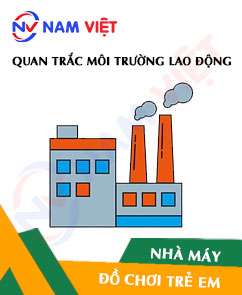
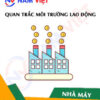
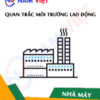

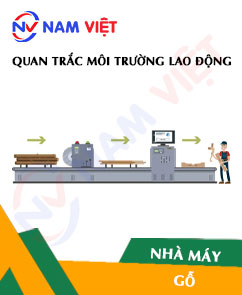
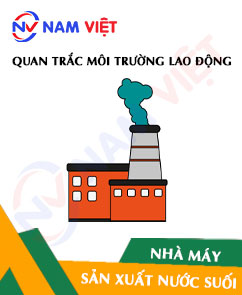


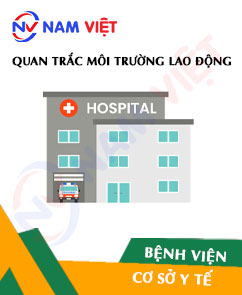
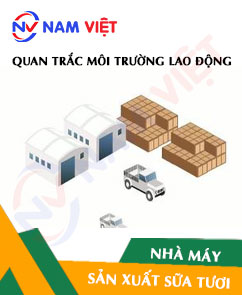

Review Occupational environment monitoring of a children’s toy manufacturing factory
There are no reviews yet.